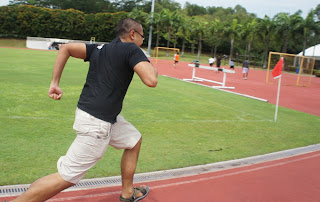Time and date: 12 July 2011, Wednesday at 3pm.
Venue: H211
Materials required:
- Our calibrated sphygmomanometer (Osim uCheck 300)
- 2 x measuring tapes
- Declaration forms
- Pen and paper for record taking
- Ruler
Subjects:
- 30 healthy young adults (15 males and 15 females) with no underlying medical conditions
- Between 18 to 24 years old
- 5 subjects from 6 different height groups:
a) 150cm to 155cm
b) 156cm to 160cm
c) 161cm to 165cm
d) 166cm to 170cm
e) 171cm to 175cm
f) 176cm to 180cm
Rationale for the subjects and time chosen for data collection:
We selected our course mates as our test subjects as they fall within the age group of 18 to 24 years old. The readings were taken after our Pathology lecture had ended, which was 2 hours after lunch break. This was to ensure that our test subjects had not engaged in any activities that were physically demanding and were given enough time to digest their lunch so that the readings of their blood pressures would not be affected.
Our team had arranged with the subjects earlier on that we would be collecting their height and pressure readings directly after the lecture. This arranged consent would allow us to collect the data efficiently and the physical condition of the different subjects would not differ too much.
Regrettably, we were unable to find the same number of male and female subjects. It would have been ideal, but the focus of our project was to find out if there was any relationship between height and blood pressure and as such, gender was not a major component of our variables. In the end, we managed to find 18 female and 12 male subjects.
Process of collecting the data:
We had discussed on the sequence and flow of data collection beforehand and our roles were assigned as such:
Yi Xuan: Photographer for the day. She was tasked with taking pictures while we were carrying out the collection of the data. The photos contributed to the visual element of our blog so you won't feel overwhelmed by the sea of words here :P
Jodie (Yan Wei) and Hui Ting: In charge of height measurement area. Jodie took the height of our subjects while Hui Ting did the recording.
Xin Hui and Fadilah: In charge of blood pressure readings. Xin Hui took the blood pressure of our subjects while Fadilah did the recording.
Sabree: Tasked with coordinating and directing our subjects so that we could take the blood pressure and height readings smoothly. This would also ensure that the process of data collection was efficient.
The set-up of our height measurement area included taping 2 measuring tapes vertically against the wall. As the measuring tape was only 150cm, it was not feasible to tape it against the wall with the tape starting from the floor. Therefore, we measured 100cm first and taped the 10cm point starting from the 100cm mark. This was done so as to eliminate the possibility of zero error, as the 0cm mark could have been affected by previous usage. The same set up was done for the second measuring tape and we took the average height from both readings to minimise errors.
Before the readings of the height and blood pressure were taken, Sabree distributed a form to our subjects to declare that they were suitable candidates for data and that they were giving us their informed consent that their readings would be used for our project.
Sabree arranged the sequence of the subjects and we soon began taking our readings!
Xin Hui was tasked with putting on the sphygmomanometer for all our subjects to achieve consistency on the data collected and the readings were recorded by Fadilah. Each subject was required to have their blood pressure reading taken twice with the second reading being taken after five minutes. The average of the readings were taken for accuracy and consistency.
Our subjects took their height after taking the readings of their blood pressure.
Jodie measured the height of all our subjects for consistency while Hui Ting recorded their average height.
The entire process went smoothly as we managed to gather the data we had initially planned to collect without much hiccup. Read on to find out if our hypothesis stands!
 What a fantastic project.
What a fantastic project.

























